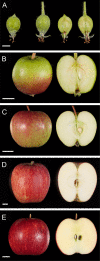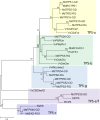Functional genomics reveals that a compact terpene synthase gene family can account for terpene volatile production in apple
- PMID: 23256150
- PMCID: PMC3561019
- DOI: 10.1104/pp.112.208249
Functional genomics reveals that a compact terpene synthase gene family can account for terpene volatile production in apple
Abstract
Terpenes are specialized plant metabolites that act as attractants to pollinators and as defensive compounds against pathogens and herbivores, but they also play an important role in determining the quality of horticultural food products. We show that the genome of cultivated apple (Malus domestica) contains 55 putative terpene synthase (TPS) genes, of which only 10 are predicted to be functional. This low number of predicted functional TPS genes compared with other plant species was supported by the identification of only eight potentially functional TPS enzymes in apple 'Royal Gala' expressed sequence tag databases, including the previously characterized apple (E,E)-α-farnesene synthase. In planta functional characterization of these TPS enzymes showed that they could account for the majority of terpene volatiles produced in cv Royal Gala, including the sesquiterpenes germacrene-D and (E)-β-caryophyllene, the monoterpenes linalool and α-pinene, and the homoterpene (E)-4,8-dimethyl-1,3,7-nonatriene. Relative expression analysis of the TPS genes indicated that floral and vegetative tissues were the primary sites of terpene production in cv Royal Gala. However, production of cv Royal Gala floral-specific terpenes and TPS genes was observed in the fruit of some heritage apple cultivars. Our results suggest that the apple TPS gene family has been shaped by a combination of ancestral and more recent genome-wide duplication events. The relatively small number of functional enzymes suggests that the remaining terpenes produced in floral and vegetative and fruit tissues are maintained under a positive selective pressure, while the small number of terpenes found in the fruit of modern cultivars may be related to commercial breeding strategies.
Figures









Similar articles
-
Volatile emissions of scented Alstroemeria genotypes are dominated by terpenes, and a myrcene synthase gene is highly expressed in scented Alstroemeria flowers.J Exp Bot. 2012 Apr;63(7):2739-52. doi: 10.1093/jxb/err456. Epub 2012 Jan 20. J Exp Bot. 2012. PMID: 22268153 Free PMC article.
-
Genetic control of α-farnesene production in apple fruit and its role in fungal pathogenesis.Plant J. 2019 Dec;100(6):1148-1162. doi: 10.1111/tpj.14504. Epub 2019 Sep 19. Plant J. 2019. PMID: 31436867
-
Identification and functional analysis of floral terpene synthase genes in Curcuma alismatifolia.Planta. 2024 Jun 11;260(1):26. doi: 10.1007/s00425-024-04440-z. Planta. 2024. PMID: 38861179
-
The family of terpene synthases in plants: a mid-size family of genes for specialized metabolism that is highly diversified throughout the kingdom.Plant J. 2011 Apr;66(1):212-29. doi: 10.1111/j.1365-313X.2011.04520.x. Plant J. 2011. PMID: 21443633 Review.
-
Plant specialized metabolism: Diversity of terpene synthases and their products.Curr Opin Plant Biol. 2024 Oct;81:102607. doi: 10.1016/j.pbi.2024.102607. Epub 2024 Jul 24. Curr Opin Plant Biol. 2024. PMID: 39053147 Review.
Cited by
-
Transcriptome sequencing of two phenotypic mosaic Eucalyptus trees reveals large scale transcriptome re-modelling.PLoS One. 2015 May 15;10(5):e0123226. doi: 10.1371/journal.pone.0123226. eCollection 2015. PLoS One. 2015. PMID: 25978451 Free PMC article.
-
Transcriptome sequencing and expression analysis of terpenoid biosynthesis genes in Litsea cubeba.PLoS One. 2013 Oct 9;8(10):e76890. doi: 10.1371/journal.pone.0076890. eCollection 2013. PLoS One. 2013. PMID: 24130803 Free PMC article.
-
Acid Soil Improvement Enhances Disease Tolerance in Citrus Infected by Candidatus Liberibacter asiaticus.Int J Mol Sci. 2020 May 20;21(10):3614. doi: 10.3390/ijms21103614. Int J Mol Sci. 2020. PMID: 32443846 Free PMC article.
-
Genomic Analysis of Terpene Synthase Family and Functional Characterization of Seven Sesquiterpene Synthases from Citrus sinensis.Front Plant Sci. 2017 Aug 24;8:1481. doi: 10.3389/fpls.2017.01481. eCollection 2017. Front Plant Sci. 2017. PMID: 28883829 Free PMC article.
-
Functional characterization of a terpene synthase responsible for (E)-β-ocimene biosynthesis identified in Pyrus betuleafolia transcriptome after herbivory.Front Plant Sci. 2022 Nov 21;13:1077229. doi: 10.3389/fpls.2022.1077229. eCollection 2022. Front Plant Sci. 2022. PMID: 36479507 Free PMC article.
References
-
- Anet EFLJ. (1970) Synthesis of (E,Z)-α-, (Z,Z)-α-, and (Z)-β-farnesene. Aust J Chem 23: 2101–2108
-
- Anet EFLJ. (1972) Superficial scald, a functional disorder of stored apples. VIII. Volatile products from the autoxidation of alpha-farnesene. J Sci Food Agric 23: 605–608
-
- Arimura G, Huber DP, Bohlmann J. (2004) Forest tent caterpillars (Malacosoma disstria) induce local and systemic diurnal emissions of terpenoid volatiles in hybrid poplar (Populus trichocarpa × deltoides): cDNA cloning, functional characterization, and patterns of gene expression of (−)-germacrene D synthase, PtdTPS1. Plant J 37: 603–616 - PubMed
Publication types
MeSH terms
Substances
Associated data
- Actions
- Actions
- Actions
- Actions
- Actions
- Actions
LinkOut - more resources
Full Text Sources

